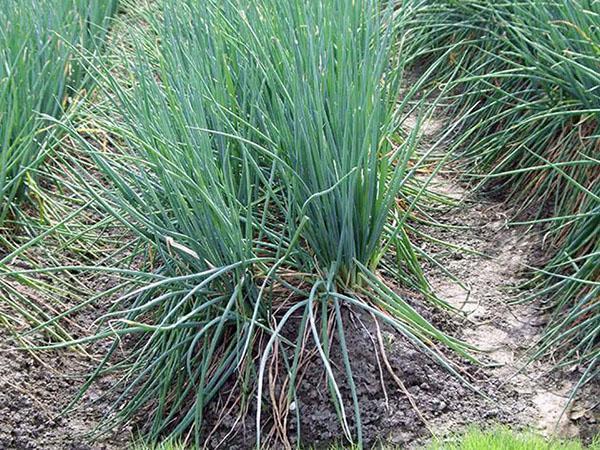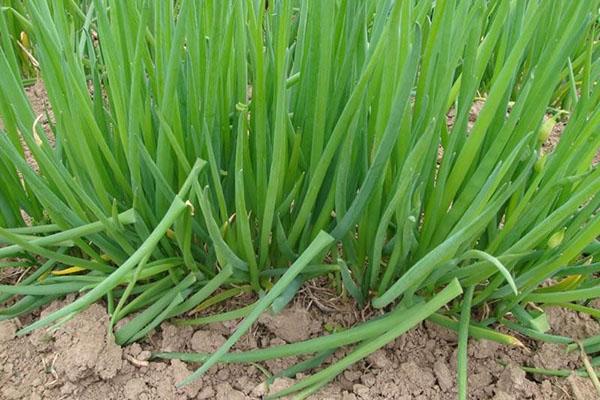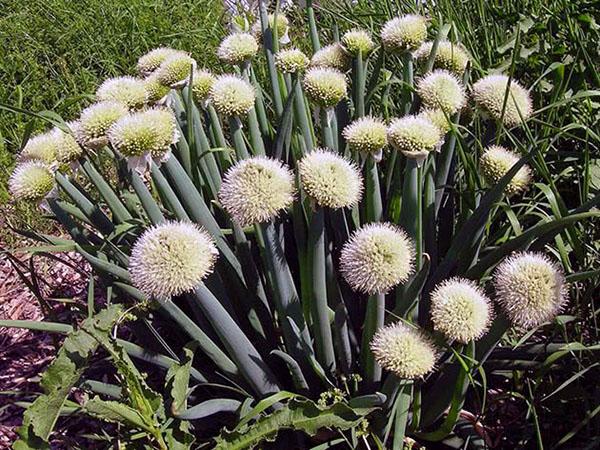Wonderful onion-batun: growing and care in summer cottages

In ancient times, meat dishes were seasoned with bitter herbs to give them an excellent taste. The original plant - the onion, the cultivation and care of which does not require special skills, is loved by many modern summer residents. It differs from its relatives in the absence of a head, therefore it is used as greenery. Compared with onions, the product has a more delicate taste and sophisticated aroma. China, Mongolia or Asia are considered its homeland. Despite this, the cultivation of onion and its care attracts gardeners all over the world.
Culture has other names as well. The most popular names are Tatar, Chinese, fisty bow and sandpiper.
External features of the plant

Batun onions are perennial crops that form small bunches. They consist of several poorly developed elongated bulbs. The ground part of the plant smoothly turns into a false stem and hollow leaves of a fist-like character.
With proper cultivation and care of batun onions, gardeners receive greens up to 1 m high. Often the garden bed turns into a wide and thick layer. Fisty leaves are colored deep green. Bulbs are either white or red.

In the second year after planting, the culture throws out an arrow. Then umbellate inflorescences of a spherical shape appear on it, consisting of many buds. After pollination, small black seeds ripen.

At the 4th year of life, the yield of the crop decreases significantly. Therefore, the plantation is renewed by planting young greenery.
Batun onion, growing and care: basic rules

There are several ways to propagate a green culture:
- by dividing the bush;
- sowing seeds;
- growing seedlings.
In the first method, young bushes are divided into parts. In each, 3 or 5 shoots are left. Then they are planted in open ground to a depth of about 2 cm. The distance between the holes should be at least 25 cm. Otherwise, the plant will suffer from a lack of fresh air, which leads to diseases. Such a planting of a batuna onion is done in the spring at a stable air temperature. As a result, there will be constantly fresh herbs on the table.

Before sowing a crop on a garden bed, it is carefully prepared. The land is plowed deeply, removing the roots weeds and the remains of various plants.
If necessary, add the following fertilizers to the soil:
- humus;
- compost;
- potassium sulfate;
- ammonium nitrate;
- superphosphate.
Gardeners have noticed that the onion grows wonderfully on slightly acidic or neutral soil. The ideal option for him is loam or sandy loam. In its homeland, the culture grows in low-lying areas where there is enough moisture. However, in Europe in such places, water often stagnates, which adversely affects the growth of onions.
Excess moisture causes the crop to throw out the arrow. As a result, the greens become tough and not tasty.
If acidic soil prevails at the summer cottage, it is ennobled with ash or lime. For 1 m², it is enough to add 250 g of ash 6 months before sowing. Lime is added to the soil in the fall (about 200 g per 1 m²) before plowing.

Interestingly, the sowing time of the onion seeds depends on the expected result. In order for the greens to appear in the middle of summer, the culture is sown in the beds in early spring. For autumn harvest - no later than mid-August. Sowing a vegetable for the winter is carried out, taking into account the climatic conditions (October, November).
When the soil is ready, start sowing the plant. Shallow holes are made, about 3-4 cm, and the seeds are lowered. The distance between the rows is at least 20 cm. Then the area is leveled and slightly compacted. If desired, mulch with humus.
The perennial beds are covered with spruce branches in the fall in order to keep more snow.
Growing seedlings

According to experienced gardeners, it is best to grow onions using seedlings. This is the way that is practiced in Asian countries. Thanks to this, the culture is not affected by powdery mildew and fresh herbs appear on the table faster. To figure out how to properly plant the onion for seedlings, we will consider the process in stages.

First, prepare a suitable soil. To do this, humus is mixed with turf soil. Then add there wood ash and mineral fertilizers. The substrate is sterilized in a microwave or preheated oven. Some gardeners will neutralize the soil with potassium permanganate solution. The prepared soil is placed in small containers or cups. Then the seeds are sown. The process begins 2 months before planting the crop in the beds.
Watering is carried out using a spray gun in order to evenly distribute moisture over the entire surface of the soil. The interval of the procedure is 2 times a week. The room maintains a stable air temperature. It must be at least + 18 ° C. The first shoots appear in 30 days. The rooted culture is planted in the beds in June, taking into account the climatic conditions of the territory. The first greens of the culture are harvested 45 days after transplanting.
Most often, this growing method is used for an annual plant species.

In addition, planting and caring for the onion includes:
- regular weeding of the topsoil;
- feeding with minerals;
- if necessary, treatment against pests and diseases.
Carefully following all procedures, many summer residents get bountiful harvests. The product is a storehouse of valuable trace elements and vitamins all year round. In addition, onions are often canned or made into spicy puree.
We do not miss important points

Whether it is spring or fall to plant the onion, there are a few other factors to consider. The plant needs constant moisture. With its lack, the feathers begin to coarse, acquiring a bitter taste. In addition, peduncles appear quite quickly on the culture. As a result, the leaves lose their nutritional properties.

There is also another extreme. With frequent watering of the beds or an abundance of rain, a crust forms on the soil surface. It prevents oxygen from reaching the root system. As a result, the plant begins to weaken and may even die. Therefore, experienced gardeners weed the beds both after rain and watering.
If you do not plan to collect seeds, it is advisable to remove the arrows immediately after they appear.
As you know, the onion is propagated not only with the help of seeds. Therefore, in the fall, lush bushes are chosen to divide them into several parts. The sprouts are planted on a new bed at a distance of 10 cm. Usually the culture has time to take root before the onset of cold weather.

In the last decade of October, they begin to prepare the onion for winter. To do this, cover the area with the plant:
- a layer of sawdust;
- old bags;
- spruce branches;
- straw.
To keep the artificial protection from frost, it is pressed with boards. Also, do not forget about rodents. Old metal buckets, which have no bottom, will help protect the culture from mice. They are installed on top of onion bushes, protecting access to "hungry" pests. Only those who apply the advice of seasoned gardeners collect bountiful harvests of juicy greens every year.

An amazing culture - the onion is grown today almost throughout Europe. Some people like to do this in their beds using seeds.Others use seedlings to speed up the maturation of the crop. The townspeople grow it in apartments or on the balcony. The main thing is that there is always tasty, juicy and healthy greens on the table.